# RC Airplane Series – 1
RC Airplanes are fun to make and really a nice beginning step to understand Aeromodelling. This series aims to cover the aspects necessary for the modelling of RC aircraft and this will teach you can you design your own RC airplane based on your constraints/requirements !!
In this article, we are going to discuss about one of the most important aspect of the airplane, i.e. Wings.

Table of Contents
What’s the principle behind this ?
So, in order to understand about how the wings help to generate the lift, we need to know about the Bernoulli’s Principle. It states that:
” The sum of the pressure, kinetic energy density & the gravitational potential energy density at a point in streamline remains constant “
The mathematical equation for this looks like :

All this looks a bit complicated, isn’t it !?
But the only thing which we require from this equation, to understand the reasoning is that :
“As pressure increases, velocity in that region decreases & vice versa is also true”

Conducting a small activity
What do we need ?
- A-4 sheets x2
- A quiet room (FANS OFF please !)
Procedure :
- Hold the 2 papers vertically with each paper in each hand.
- Observe that nothing happens here
- Now, blow air with your mouth into the region B (region between the 2 papers)
- Observe what happens !!
The step-by-step procedure & it’s result is shown in the figure below ( !! Not that good at drawing, but pls manage !! :)) )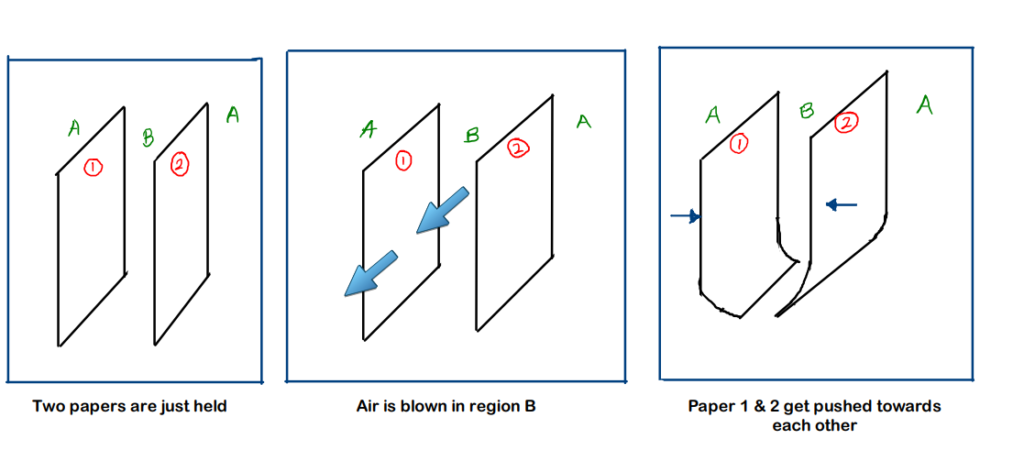
Fig. A-4 sheets experiment procedure
Why did this exactly happen !?
Note : The region between the 2 sheets is named as ‘B’ while the region except B is called ‘region A’ (i.e. the surroundings to region B)
- Initially, the pressure in region B and A is the same since the velocity of air is same everywhere
- Now, we blow air into the region B (between the sheets). This causes the velocity of air in the region B to increase in comparison to its surroundings (region A)

3. Now, by Bernoulli’s principle we can derive the conclusion that,

4. Because of this, the sheets are pushed towards each other by the surroundings due to the relative higher pressure of the surroundings than that of the region B
About Aerofoil Shape
Now, to use the above results into an application, we have a shape known as ‘Aerofoil’. We can describe this shape by its upper and the lower surface. The upper surface has a curvature known as ‘Camber’ and the upper surface has larger length as compared to lower surface which is done purposely.
To understand the shape, have a look at the figure below. (I will try improving my drawing skills !!)

Fig. Aerofoil shape explanation
1. Consider points A and B. At point A, the streamlines diverge to pass over the aerofoil and then meet up again at point B. Now, we that the flow is streamlined and laminar, the air particles flowing over the upper surface have to keep up with the air particles passing under the lower surface.
2. We already know that the upper surface has greater length as compared to lower one. Hence to meet at B at same instant, the velocity of air passing over the upper surface has to be greater since it has to cover more distance in the same time.
Hence,

But, by Bernoulli’s principle we know that,

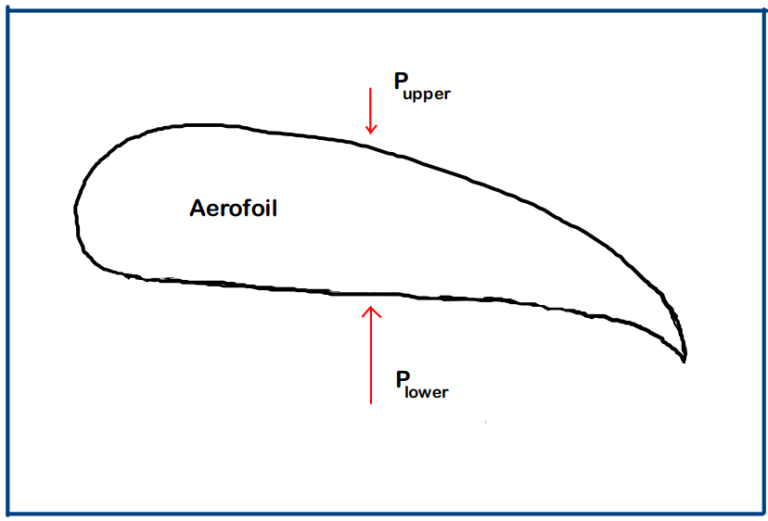
This is how lift is generated !! & we can see that the aerofoil shape has a lot of role to play in this.
Some frequently used terms in Aerodynamics
Leading Edge & Trailing Edge :
– Leading edge is the foremost edge of the wing. This is the first part of the wing which comes in contact with the air flow. It is mostly rounded in order to have a smooth airflow over the wing.
– Trailing edge is the rearmost edge of wing. This is the portion where the airflow leaves the wing. This edge of the wing includes the control surfaces with Ailerons and the Flaps
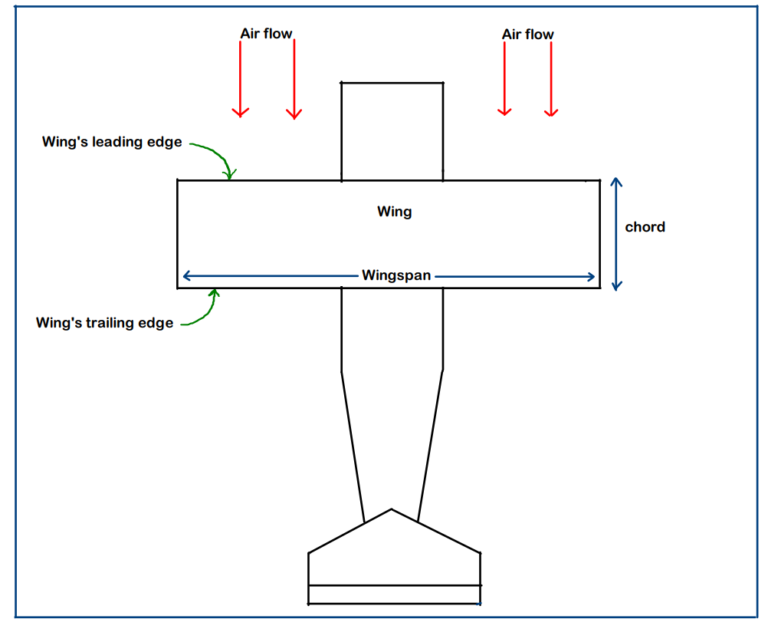
Chord :
– The distance (straight line length) between the leading edge and the trailing edge of the wing is called ‘chord’.
– It is not always that the wing will be rectangular, so, in that case we consider the ‘mean’ chord length which can be calculated based on the shape of the wing.

– For rectangular wing, the width of the rectangle becomes the chord.
Vortex Drag :
– Now, this is something which comes as a by-product with the ‘Lift’ which we don’t need and hence we must try to atleast minimize it as much as possible.
Fig. explanation : When the air flows over the Wings, lift is generated & simultaneously, wing tip vortices are also formed which we need to minimize since it consumes fuel, hence dropping the fuel efficiency of plane.
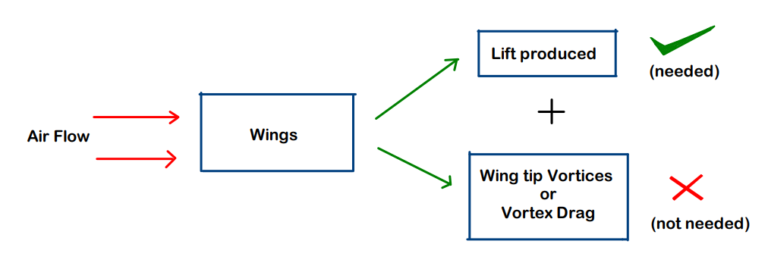
Why does it happen ?
– The wing is an finite dimension part and hence it will come to an end at some point. This is the point which we call as
‘Wing tip’. Just at the wing tips, there is still a high pressure region below and a low pressure region above. This pressure difference causes the air particles to execute a rotational type of motion which we call ‘vortex’
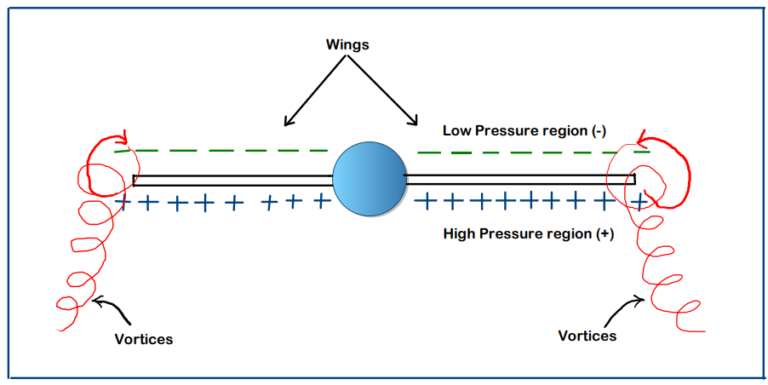
Now due to this, 1. The air particles exhibit rotational motion (as we see in the figure)
2. But from where do these particles get energy to exhibit this rotational motion
3. This energy is extracted from the wings (or indirectly, the part of the fuel is getting consumed to overcome this drag)
4. Therefore, we conclude that, the induced drag affects the fuel efficiency of airplane
Aspect Ratio (AR):
– Aspect Ratio is defined as the ratio of the wingspan to the mean chord length
– It is one of the most characteristic of the object (here airplane) and AR for an aircraft is determined based on the work it is going to be used for.

For example,
– High Aspect Ratio : Used to have more fuel efficiency for aircraft (due to lesser induced drag)
– Moderate Aspect Ratio : Used to get the benefits of both : maneuverability & fuel efficiency
– Low Aspect Ratio : Used to get more maneuverability (ability to change direction)
Wingspan is everything !
While designing the RC airplane, the first most important thing which you need to fix, is the ‘Wingspan’ of your aircraft. Wingspan is nothing but the length of your wing (including fuselage width).
Generally, while designing the RC Aircraft, we have a fixed set of ratios defined which tell us what all dimensions should different parts/components of airplane have.
For examples, we take some ratios like: (We fix Wingspan = 1m)
1. The fuselage length = 75% of wingspan
= 75 % of 100cm
= 75 cm
2. Now for Trainer Aircraft, Aspect Ratio is 5:1
hence, chord = wingspan/5
= 100/5
= 20cm
3. Aileron length has to be 1/4th of wingspan
Aileron length = (1/4) x wingspan
= (1/4) x 100cm
= 25cm
We can clearly see that in all calculations, somehow or the other, ‘Wingspan’ is getting involved.
There are still many dimensions you can calculate directly/indirectly using wingspan…
Conclusion
To conclude this post, we learnt about the basic working principles of wings. Just making an RC Airplane is one thing while Understanding the RC Airplane is another thing. We are going to focus on the understanding part first which will surely make our further work much more easier + the additional satisfaction that we know the reasoning behind what we are doing !!
Till then, Keep Learning & Enjoy the Process !!
RC Airplane Series – All Articles (You are at Part-1 !)
- Part-2 (Next) : Understanding the control surfaces !
- Part-3 : Designing your Airplane !!
- Part-4 : Motor and Propeller Selection
- Part-5 : How to choose LiPo Battery ?
- Part-6 : ESC Calculations and Electronics Connection


